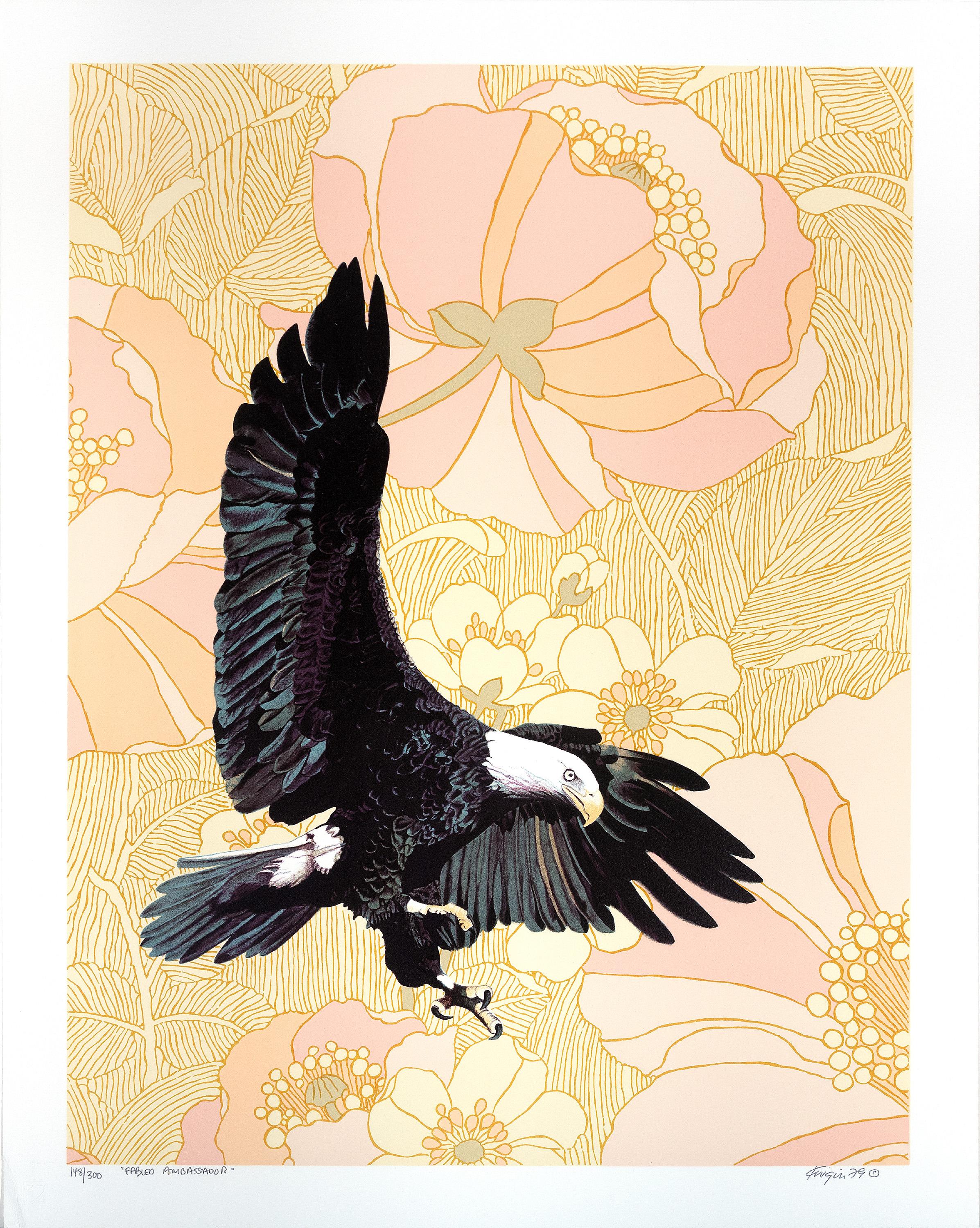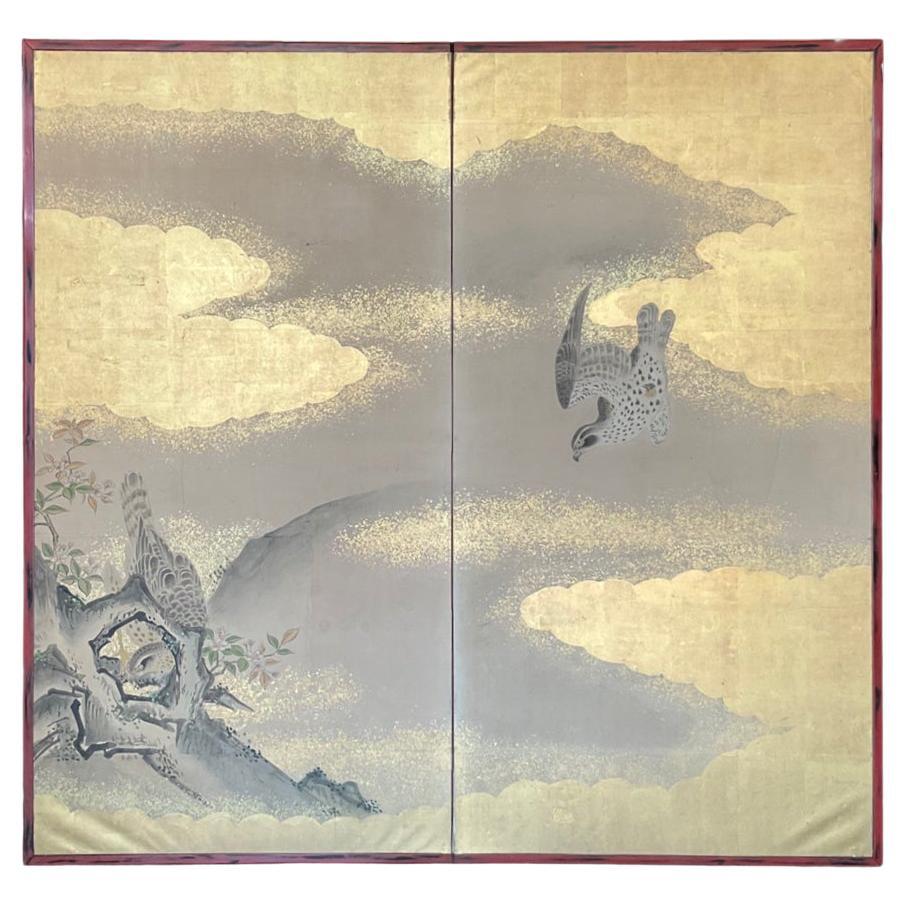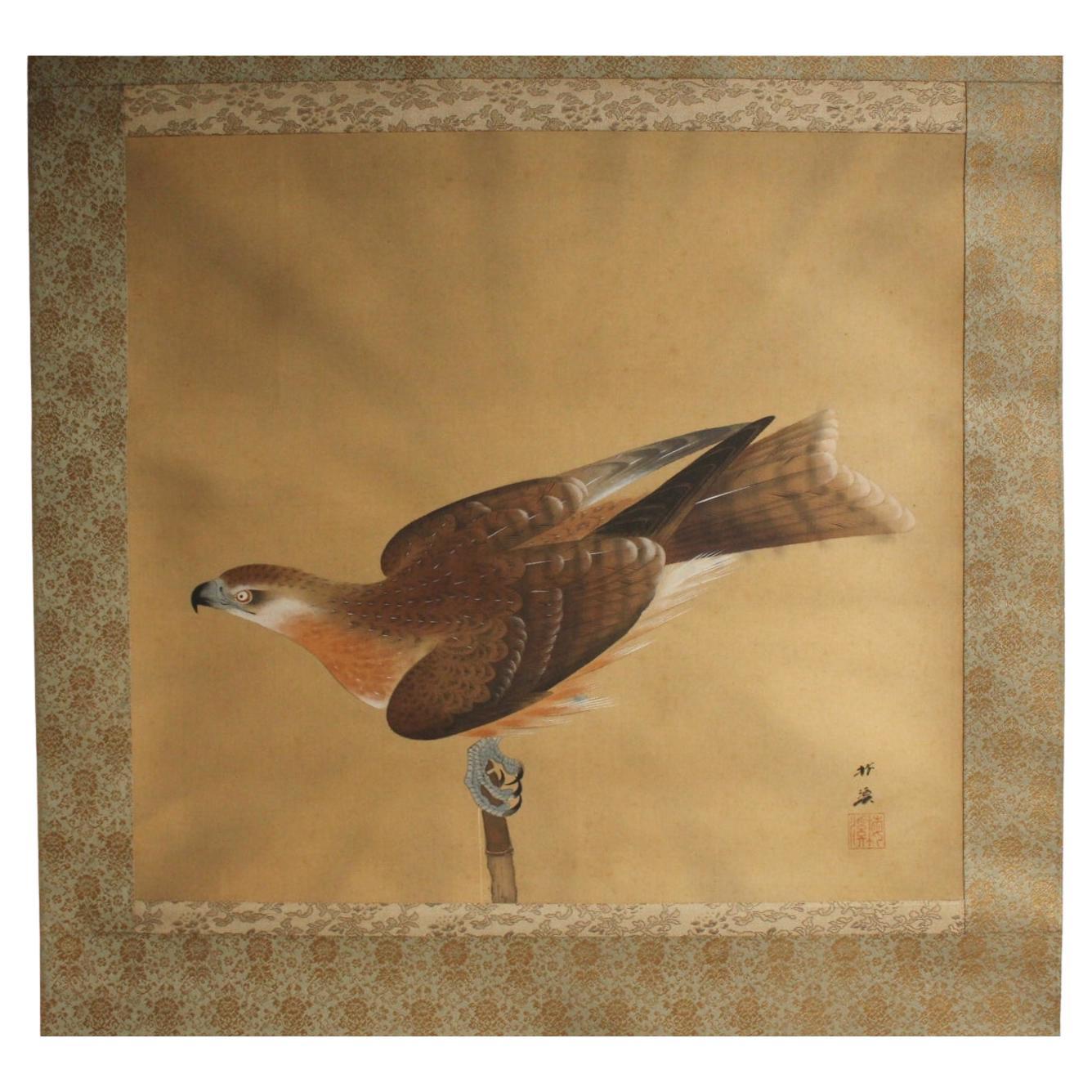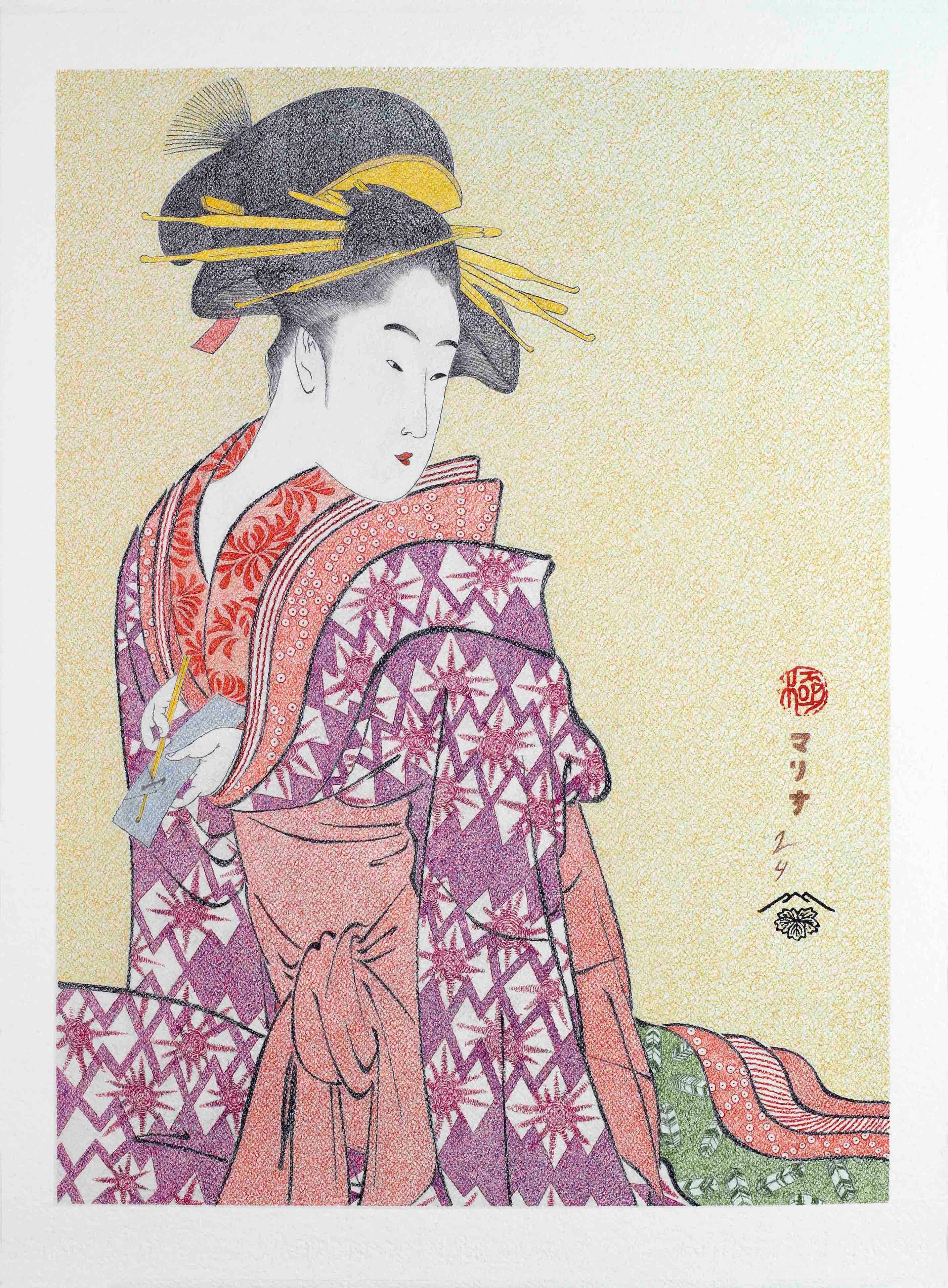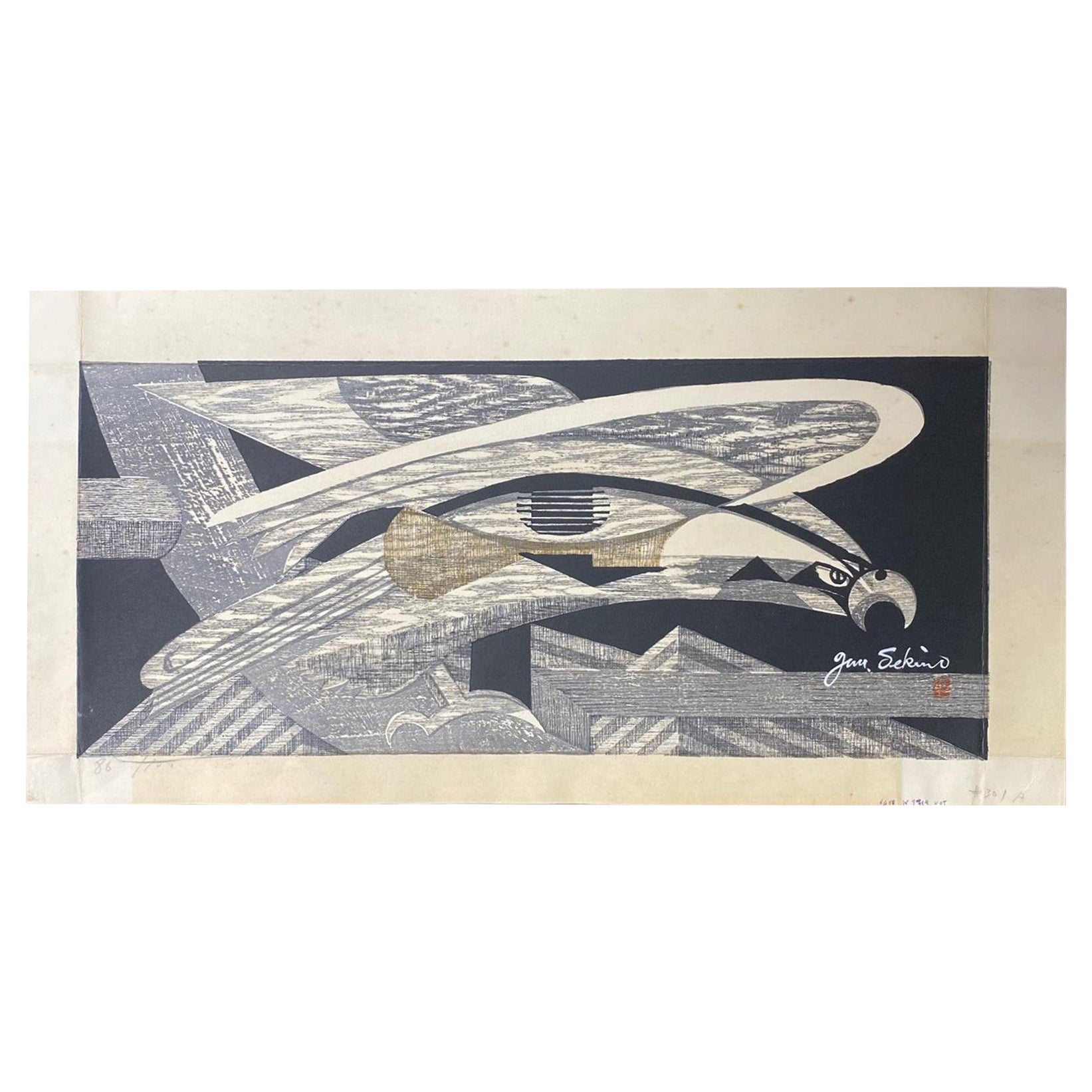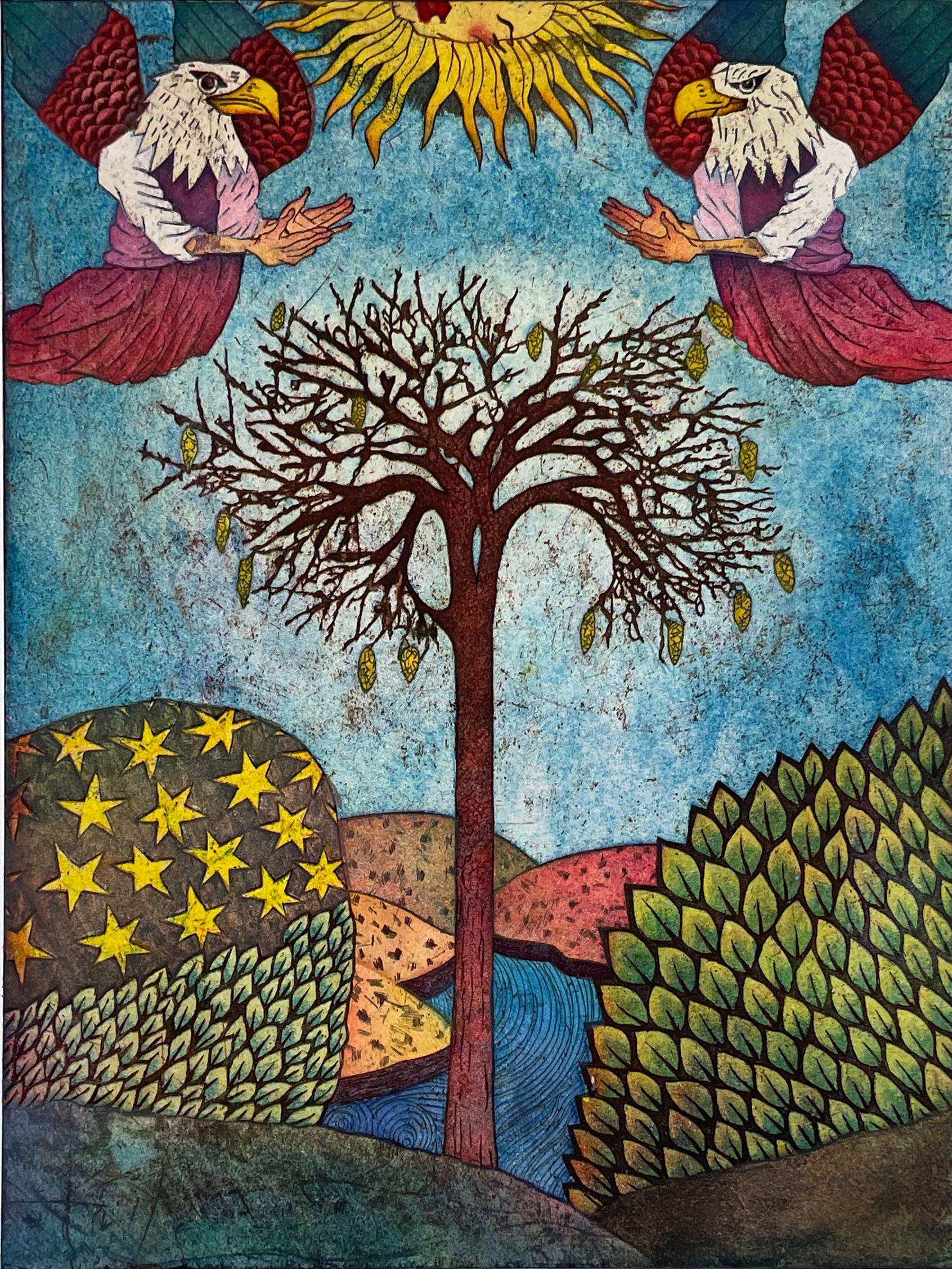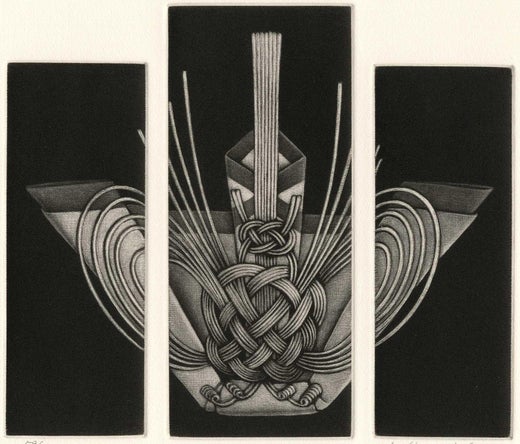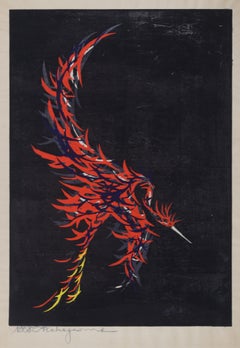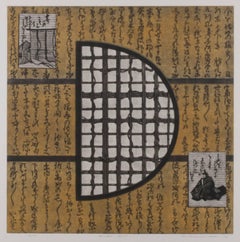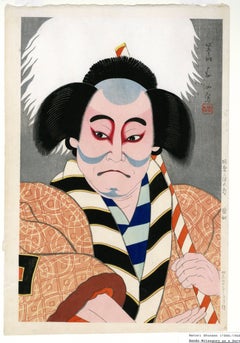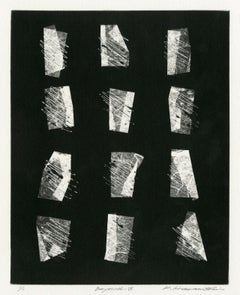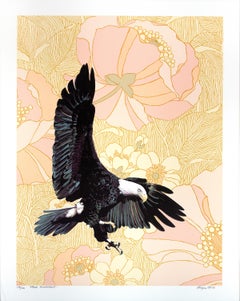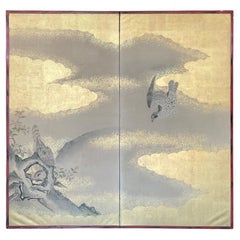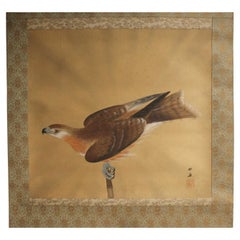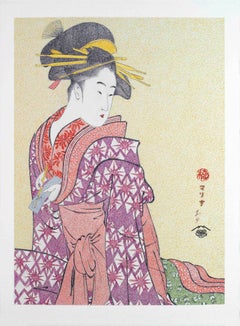Items Similar to White Head Eagle
Want more images or videos?
Request additional images or videos from the seller
1 of 10
Katsunori HamanishiWhite Head Eagle2014
2014
$1,250
£947.82
€1,087.47
CA$1,778.60
A$1,929.38
CHF 1,014.57
MX$23,476.60
NOK 12,683.80
SEK 11,962.39
DKK 8,119.38
About the Item
White Head Eagle
Mezzotint printed in colors, 2014
Signed lower right (see photo)
Titled lower center (see photo)
WHITE HEAD EAGLE. The Print Club of Cleveland Publication No. 94, 2016
Printed in 2014 by the artist in Japan.
Printed on Japanese Mat Thunders wove paper
"In order to produce this print titled White Head Eagle (the translation of bald eagle), I considered that I am an artist who lives in Japan and The Cleveland Print Club is an organization in the United States. I decided to express the relationship between the two cultures in my style, using the Japanese costume, kimono, as a canvas. I placed the symbol of America, a white headed eagle at the collar of the kimono. And then at the hem, I depicted the ocean with big waves in which I tried to express today’s world. Since ancient times in Japan tagasode, the gorgeous women’s kimonos that were hanging on a kimono rack, have often appeared on screens. This time, I decided to use the traditional Japanese composition with tagasode. I hope all the members of the Cleveland Print Club will enjoy this print."
Condition: Mint
Image/Plate size: 19 9/16 x 14 3/16 inches
Sheet size: 23 9/16 x 15 5/8 inches
In Japan the print has occupied a very important position as an art form. Over a long and distinguished career Katsunori Hamanishi has focused on the production of mezzotint prints, perhaps the most demanding of all print techniques. Hamanishi creates images with both subtle details and dynamic compositions that explore spatial relationships. His work is celebrated for balancing calm and meditative qualities with energetic tensions of inanimate and natural objects. There is a sense of mystery and intrigue in his prints.
Hamanishi was born on Hokkaido, Japan’s second largest island. In 1973, he finished his studies at Tokai University in Kanagawa prefecture. His work has been exhibited internationally in Paris, Belgium, Philadelphia, Tokyo, Kyoto, Cairo and San Francisco as well as in the Ibiza International Print Biennial and the Valparaiso International Exhibition, Chile. In 2012 The Art of Darkness opened at the Arthur M. Sackler Gallery in Washington DC featuring Hamanishi’s mezzotints along with those of Yozo Hamaguchi (he created Papillon Rouge, Publication Print No. 51 from 1973). In 2013 Hamanishi had a one-man show at the Art Institute of Chicago.
Hamanishi’s connection to Cleveland goes back to 1986 when printmaking professor H. Carroll Cassill invited him to come as a visiting artist at the Cleveland Institute of Art. At that time he was already a respected artist who had received prizes at renowned international exhibitions. Hamanishi remarked, “This wonderful and unforgettable experience at the Cleveland Institute of Art made it possible for me to visit the United States later. In 1987 the Japan Agency for Cultural Affairs selected me and sponsored my study in the U.S.”
Under that grant, Hamanishi studied at the University of Pennsylvania. He, his wife Tsuyako and their two sons stayed in Philadelphia for a year while he studied art and produced new work. Hamanishi returned to the Cleveland Institute of Art in 1998 and again in 2014 to conduct mezzotint demonstrations.
Hamanishi is at home with both Japanese and western art history although many of his subjects are borrowed from the Japanese tradition. His favorite themes are objects that can be shown three-dimensionally like ropes, plants and the twigs of a tree. It may be that he chooses the most difficult objects to demonstrate his skillful draftsmanship and mastery of mezzotint. In recent years Hamanishi has begun to add a bright touch of red or green as a contrapuntal note to detailed compositions, and these sudden bursts of color emphasize even more the dazzling brilliance of his creative imagery.
Mezzotints are known for a dark and atmospheric appearance. The first step in producing a mezzotint is to roughen the surface of the copper plate which produces a solid black shape when printed. Then burnishers and scrapers are used to remove the texture on the plate to create a wide variety of tones and highlights. The process is difficult and laborious but the results have a special velvety appearance.
Hamanishi - White Head EagleIn his recent series on kimonos, which includes the Print Club print, Hamanishi uses the “Whose Sleeves?” tagasode motif. This theme depicts beautiful kimono draped across a wooden rack. It was a popular subject during the late Momoyama and early Edo periods of the sixteenth and early seventeenth centuries. Although highly decorative, tagasode had deep literary connotations of a woman whose absence is keenly felt. The beautiful sleeves evoke the image of an elegant woman and the fragrance arising from her kimono. The phrase “Whose Sleeves?” is found in classical love poems and was not commonly used to refer to this type of image until the late nineteenth century.
Works by Hamanishi are in the following public collections:
The British Museum, London
Metropolitan Museum of Art, New York
Museum of Modern Art, New York
Art Institute of Chicago
National Museum of Art, Osaka
Library of Congress, Washington, DC
Art Gallery of New South Wales, Australia
Philadelphia Museum of Art, Pennsylvania
Hokkaido Museum of Modern Art, Sapporo
Krakow National Museum, Poland
Museum of New Zealand, Te Papa Tongarewa
Cleveland Museum of Art
Achenbach Foundation for Graphic Arts, San Francisco
- Creator:Katsunori Hamanishi (1949, Japanese)
- Creation Year:2014
- Dimensions:Height: 19.57 in (49.71 cm)Width: 14.19 in (36.05 cm)
- Medium:
- Movement & Style:
- Period:
- Condition:
- Gallery Location:Fairlawn, OH
- Reference Number:Seller: FA126021stDibs: LU14015288372
Katsunori Hamanishi
Katsunori Hamanishi was born in 1949 on Hokkaido island, Japan's second-largest island. In 1973, he finished his studies at Tokai University in Kanagawa prefecture. In 1987 and 1988, he studied at the University of Pennsylvania through a grant by a US cultural institution. At that time, Hamanishi was already a respected artist, who had received prizes at renowned international exhibitions.
About the Seller
5.0
Recognized Seller
These prestigious sellers are industry leaders and represent the highest echelon for item quality and design.
Platinum Seller
Premium sellers with a 4.7+ rating and 24-hour response times
Established in 1978
1stDibs seller since 2013
815 sales on 1stDibs
Typical response time: <1 hour
Associations
International Fine Print Dealers Association
- ShippingRetrieving quote...Shipping from: Akron, OH
- Return Policy
Authenticity Guarantee
In the unlikely event there’s an issue with an item’s authenticity, contact us within 1 year for a full refund. DetailsMoney-Back Guarantee
If your item is not as described, is damaged in transit, or does not arrive, contact us within 7 days for a full refund. Details24-Hour Cancellation
You have a 24-hour grace period in which to reconsider your purchase, with no questions asked.Vetted Professional Sellers
Our world-class sellers must adhere to strict standards for service and quality, maintaining the integrity of our listings.Price-Match Guarantee
If you find that a seller listed the same item for a lower price elsewhere, we’ll match it.Trusted Global Delivery
Our best-in-class carrier network provides specialized shipping options worldwide, including custom delivery.More From This Seller
View AllKeshin (Incarnation (Moku)
Located in Fairlawn, OH
Keshin (Incarnation (Moku)
Color woodcut, 1958
Signed and dated lower left in pencil (see photo)
An impression is in the collectionof the Asian Art Museum, No. 2012.93, which is not a richly inked s this impression.
Another impression is in the National Museum of Art, Smithsonian, accession no. S2019.3.1297
A third impression is in the collectionof the Art Gallery of Greater Victoria
This appears to be the best and most colorful impression of the museum holdings.
The image is thought to depict a flying crame
Condition: Wrinkles to large sheet of handmade paper. Not objectionable.
Image size: 29 15/16 x 21 1/4 inches
Sheet size: 37 3/8 x 27 1/4 inches
Reference: Tadashi Nakiyama Life & Work, Plate F
Tadashi Nakayama - Sosaku hanga artist Tadashi Nakayama initially studied oil painting at Tama Art College, but began creating woodblock prints in 1951. In the 1960s, he traveled to Turkey, Greece, England, and Italy, absorbing influences from Persian and Byzantine art and the renaissance master Paolo Ucello. Throughout his long career, his subjects have included flowers, butterflies, women, and perhaps most famously, horses...
Category
1950s Abstract Abstract Prints
Materials
Woodcut
Window-No. 25
By Katsunori Hamanishi
Located in Fairlawn, OH
Window-No. 25
Color mezzotint, September 2009
Signed, titled and numbered in pencil (see photos)
Edition: 70 (16/70)
Provenance:
Ninion and Sheldon Landy Collection, Donors of Art In...
Category
Early 2000s Abstract Still-life Prints
Materials
Mezzotint
Bando Mitsugoro as a Servant with a Sword
By Natori Shunsen
Located in Fairlawn, OH
Bando Mitsugoro as a Servant with a Sword
Color woodcut, 1952
From The Series Shunsen Nigao-E Shu (Shunsen Portraits), Six Woodblock Prints
Publisher: Watanabe
Excellent condition
Im...
Category
1950s Other Art Style Portrait Prints
Materials
Woodcut
Beyound (sic) - IX
By Katsunori Hamanishi
Located in Fairlawn, OH
Beyond (sic) - IX
Mezzotint, n.d.
Signed, titled and numbered in pencil (see photos)
Edition: Unique impression (i/I)
Ninion and Sheldon Landy were major collectors of Hamanishi's works. They donated a large group of his mezzotints to Art Institute of Chicago, which formed the core of the exhibitions of his works at AIC in 2014 and again in 2019.
Condition: excellent
Plate/Image size: 9.75 x 7.75 inches
Sheet size: 12 1/2 x 9 5/8 inches
Provenance: Ninion and Sheldon Landy, Hamanishi's patrons
EXTREMELY RARE-UNIQUE
Katsunori Hamanishi
Born: 1949, Hokkaido
Medium: Mezzotint, with relief printing and metallic foil. Also a few woodblocks
Hamanishi studied painting and graduated from Tokai University with a degree in Art, in 1973. Since then, he has been living in the Tokyo area, where his primary focus is printmaking. Mezzotint is a variation of intaglio printing--an exacting and laborious process whereby ink is transferred from below the surface of the plate by use of a press. First, the entire copper plate is indented with a toothed steel rocker tool. Worked in all directions, this creates an even finely-grained texture over the surface of the plate. Each pit will hold ink and were the plate inked at this stage, it would print almost solid black.
To create the design the artist smoothes out some of the pits with a burnisher so they will hold less ink. Where highlights are required the plate is burnished and polished quite smooth. A wide range of tones are possible in mezzotint and the process can usually be recognized by a light design on a velvety black background. Hamanishi is internationally known for his mastery of this medium. He creates images with both subtle detail and dynamic composition that explore spatial relationships.
His genius is in balancing calm and meditative qualities with the energetic tensions of inanimate and natural objects. Early work had such things as pipes and branches wrapped with cloth, later rope, then straw. When he moved to a more rural area, rice fields became a common element. He has also been exploring the use of color and metallic leaf in his artwork. In 2005 Mr. Hamanishis began the Haze series exploring more abstract themes using the subtle differences between matte and black inks done in mezzotint and relief printing.
There is always a sense of mystery and intrigue in the complex mezzotint prints that come from Hamanishi’s deft hands. They compel the viewer to do a slow, thoughtful examination in order to fully absorb the vision the artist intends.
Exhibitions:
Worcester Art Museum, Massachusetts --2 person show with Hamaguchi
Ibiza Biennial, Spain--Grand Prize
Original Colored Graphic Print Triennial, Switzerland--Grand Prize
Cabo Frio International Print Biennial, Brazil--Grand Prize
CWAJ Print Show, Tokyo--Art Grant winner
Republic of China Print Exhibit--Gold Medal
Graphic Arts Council, Achenbach Foundation, San Francisco--commissioned print
Art Institute of Cleveland
University of Alberta, Edmonton, Canada--visiting artist
Shun-yo-Kai, Tokyo--prize winner
Bhara Bhavan International Print Biennale, India
Ren Brown...
Category
1980s Abstract Abstract Prints
Materials
Mezzotint
Festival No. 6
By Katsunori Hamanishi
Located in Fairlawn, OH
Festival No. 6
Color woodblock, 2002
Signed, titled and numbered in pencil (see photos)
Edition: 50 (10/50), see photo
Provenance:
Ninion and Sheldon Landy Collection, Donors to Art Inst. of Chicago
Hamanishi Exhibition, Oct. 12, 2013-January 5, 2014
Reference: Hamanishi Small 98
Condition: Excellent
Sheet: 12 1/4 x 9 1/8";
Image 10 1/2 x 7 1/2"
Katsunori Hamanishi
Born: 1949, Hokkaido
Medium: Mezzotint, with relief printing and metallic foil. Also a few woodblocks
Hamanishi studied painting and graduated from Tokai University with a degree in Art, in 1973. Since then, he has been living in the Tokyo area, where his primary focus is printmaking. Mezzotint is a variation of intaglio printing--an exacting and laborious process whereby ink is transferred from below the surface of the plate by use of a press. First, the entire copper plate is indented with a toothed steel rocker...
Category
Early 2000s Abstract Abstract Prints
Materials
Woodcut
Festival No. 6
By Katsunori Hamanishi
Located in Fairlawn, OH
Festival No. 6
Color woodblock, 2002
Signed, titled and numbered in pencil (see photos)
Edition: 50 (10/50), see photo
Provenance:
Ninion and Sheldon Landy Collection, Donors to Art Inst. of Chicago
Hamanishi Exhibition, Oct. 12, 2013-January 5, 2014
Reference: Hamanishi Small 98
Condition: Excellent
Sheet: 12 1/4 x 9 1/8";
Image 10 1/2 x 7 1/2"
Katsunori Hamanishi
Born: 1949, Hokkaido
Medium: Mezzotint, with relief printing and metallic foil. Also a few woodblocks
Hamanishi studied painting and graduated from Tokai University with a degree in Art, in 1973. Since then, he has been living in the Tokyo area, where his primary focus is printmaking. Mezzotint is a variation of intaglio printing--an exacting and laborious process whereby ink is transferred from below the surface of the plate by use of a press. First, the entire copper plate is indented with a toothed steel rocker...
Category
Early 2000s Abstract Abstract Prints
Materials
Woodcut
You May Also Like
"Fabled Ambassador (Bird Suite) " original lithograph bold bald eagle pop signed
By Michael Knigin
Located in Milwaukee, WI
"Fabled Ambassador (Bird Suite)" is an original color lithograph by Michael Knigin. The artist signed the piece in the lower right and wrote the edition num...
Category
1970s Pop Art Animal Prints
Materials
Lithograph, Ink
Majestic Hawks Edo Screen by Tosa School
Located in Fukuoka, JP
Majestic Hawks Edo Screen
Period: Edo
Size: 150x168 cm (59x66 inches)
SKU: PTA93
Step back in time to the Edo period with our superb Tosa school screen d...
Category
Antique 19th Century Edo Paintings and Screens
Materials
Gold Leaf
K14 Japanese antiques Art A hanging scroll, a hawk
Located in Niiza, JP
Color on silk, Scroll head: Porcelain
Image size: 540(W) x 490(H) [mm]
Scroll mounting: 670(W) x 1260(H) [mm]
Box size: 100(W) x 100(H) x 780(D) [mm] 1400g
Estimated packing size: 16...
Category
Antique 19th Century Japanese Paintings and Screens
Materials
Silk
Japanese Art Ukiyo-e Figurative Painting, Somenosuke of the Matsubaya Edo period
Located in Segovia, ES
Bijin-ga series XXV (Nº 25)
Title: SOMENOSUKE OF THE MATSUBAYA
Somenosuke of house Matsubaya, known as a youthful courtesan who quickly rose through the ranks of popularity is shown producing a concealed letter, glancing about to confirm she is indeed alone.
The highlights of the drawing are the fine carving of the courtesan´s hair-line and the fine dress; an elegant kimono with vivid colors and intricate dessing.
This image is part of the bijin-ga series (“Pretty women”) drawn by Mario BGil, based in the Kitigawa Utamaro woodblock print...
Category
2010s Edo Figurative Drawings and Watercolors
Materials
Paper, Crayon, Oil Crayon, Graphite
Junichiro Sekino Signed Limited Edition Japanese Woodblock Print of Eagle Hawk
By Junichiro Sekino
Located in Studio City, CA
A bold abstract limited edition woodblock print by famed Japanese artist/printmaker Junichiro Sekino featuring a fierce bird likely an eagle or hawk. The wood grain of the printing ...
Category
Mid-20th Century Japanese Showa Prints
Materials
Paper
Eagle Angels, by Yuji Hiratsuka
By Yuji Hiratsuka
Located in Palm Springs, CA
Signed and numbered from the edition of 15. Printed on Chine colle. Image of two Eagles dressed as angels, celegrating a beautiful landscape under a smilin...
Category
2010s Contemporary Landscape Prints
Materials
Intaglio
